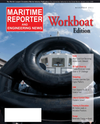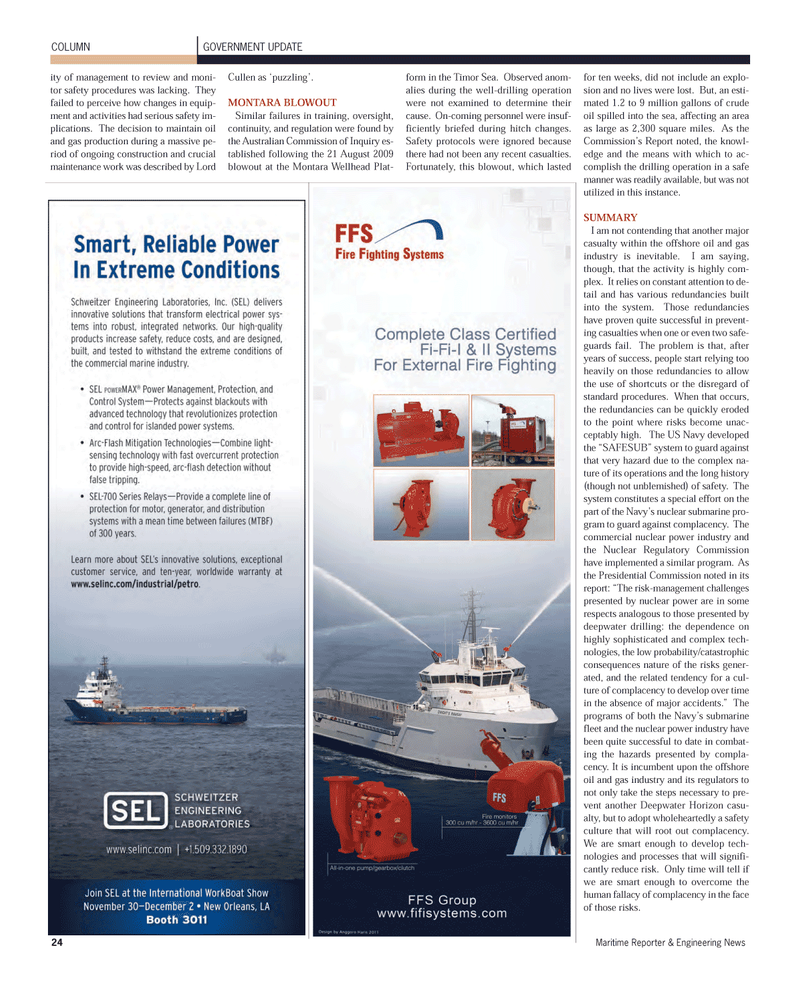
Page 24: of Maritime Reporter Magazine (November 2011)
Feature: Workboat Annual
Read this page in Pdf, Flash or Html5 edition of November 2011 Maritime Reporter Magazine
ity of management to review and moni- tor safety procedures was lacking. They failed to perceive how changes in equip- ment and activities had serious safety im- plications. The decision to maintain oil and gas production during a massive pe- riod of ongoing construction and crucialmaintenance work was described by Lord Cullen as ?puzzling?.MONTARA BLOWOUT Similar failures in training, oversight, continuity, and regulation were found by the Australian Commission of Inquiry es- tablished following the 21 August 2009 blowout at the Montara Wellhead Plat- form in the Timor Sea. Observed anom- alies during the well-drilling operationwere not examined to determine their cause. On-coming personnel were insuf-ficiently briefed during hitch changes. Safety protocols were ignored becausethere had not been any recent casualties. Fortunately, this blowout, which lasted for ten weeks, did not include an explo- sion and no lives were lost. But, an esti- mated 1.2 to 9 million gallons of crude oil spilled into the sea, affecting an area as large as 2,300 square miles. As the Commission?s Report noted, the knowl- edge and the means with which to ac-complish the drilling operation in a safemanner was readily available, but was not utilized in this instance.SUMMARY I am not contending that another majorcasualty within the offshore oil and gas industry is inevitable. I am saying, though, that the activity is highly com- plex. It relies on constant attention to de- tail and has various redundancies built into the system. Those redundancies have proven quite successful in prevent- ing casualties when one or even two safe- guards fail. The problem is that, after years of success, people start relying tooheavily on those redundancies to allow the use of shortcuts or the disregard of standard procedures. When that occurs, the redundancies can be quickly erodedto the point where risks become unac-ceptably high. The US Navy developed the ?SAFESUB? system to guard against that very hazard due to the complex na- ture of its operations and the long history(though not unblemished) of safety. The system constitutes a special effort on the part of the Navy?s nuclear submarine pro- gram to guard against complacency. The commercial nuclear power industry and the Nuclear Regulatory Commission have implemented a similar program. As the Presidential Commission noted in itsreport: ?The risk-management challengespresented by nuclear power are in some respects analogous to those presented bydeepwater drilling: the dependence on highly sophisticated and complex tech- nologies, the low probability/catastrophic consequences nature of the risks gener- ated, and the related tendency for a cul- ture of complacency to develop over time in the absence of major accidents.? The programs of both the Navy?s submarine fleet and the nuclear power industry have been quite successful to date in combat-ing the hazards presented by compla-cency. It is incumbent upon the offshore oil and gas industry and its regulators to not only take the steps necessary to pre- vent another Deepwater Horizon casu- alty, but to adopt wholeheartedly a safety culture that will root out complacency. We are smart enough to develop tech- nologies and processes that will signifi- cantly reduce risk. Only time will tell ifwe are smart enough to overcome the human fallacy of complacency in the face of those risks.GOVERNMENT UPDATE COLUMN24Maritime Reporter & Engineering News MR Nov.11 # 3 (18-24):MR Template 10/27/2011 9:09 AM Page 24

 23
23

 25
25
